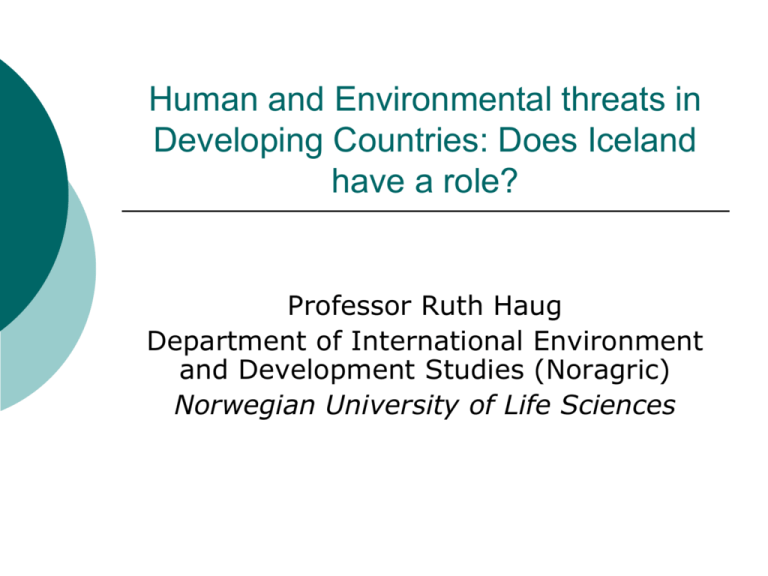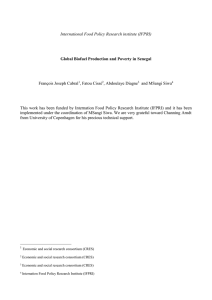Iceland
advertisement

Human and Environmental threats in Developing Countries: Does Iceland have a role? Professor Ruth Haug Department of International Environment and Development Studies (Noragric) Norwegian University of Life Sciences International Environment and Development Studies (EADI, 2006) Development Studies is a multi- and interdisciplinary field of studies (not a discipline) that seeks to understand social, economic, political, environmental, technological and cultural aspects of societal change, particularly in development countries Environmental threats Climate change Shortage of energy Water scarcity Biodiversity losses Pollution Land degradation – land shortage Deforestation UN’s PANEL ON CLIMATE CHANGE United Nations Intergovernmental Panel on Climate Change (IPCC) (2006): Average temperature of the earth’s surface, have already risen by 0.74 degrees C in the last 100 years, and is expected to increase by an average of about 3 degrees over the next century, assuming greenhouse gas emissions continue to rise at current rates. Emission (Calvin, 2007) Agriculture: 14% and Land use: 18% Transport 14% Industry 14% Power: 24% (coal, gas, oil; non-industrial electricity) Human threats Hunger and Poverty Conflicts and lack of security Human rights violation Bad governance Lack of democracy Globalization and market forces Urbanization The bottom billion: Why the poorest countries are failing and what can be done about it (Collier, 2007) World poverty 1 billion poor ($ 1) 2,7 billion ($ 2) The four poverty traps: The conflict trap The natural resource trap Landlocked with bad neighbors Bad governance in a small country Agriculture for Development: WDR08 For the poorest, GDP growth in agriculture is 4 times as effective as other growth in reducing poverty Global food supplies under pressure Environment under pressure: sustainable agriculture needed Too little public spending Under recognized potential of women Rich countries need to reform policies that harm the poor Who is affected by hunger and poverty? Urban poor 20% Fishers, herders 10% Land less, rural 20% Sm all Farm ers 50% Source: UN Millennium Project, Hunger Task Force 2005 Malnourished people (UN hunger task force, 2005) Sub Sahara Africa India Asia and Pacific China WANA 204 221 156 142 39 Food insecurity causes Poverty problem: Household level: National/international level: bad 50% peasant farmers, 20% landless, 20% urban, 10% fishers/herders lack of access to production assets, markets and employment, drought/flooding, HIV/AIDS, voiclessnes, women’s low status, vulnerability, governance, institutional failure, policy failure, conflict, lack of social security, lack or wrong international response, increased dependency Three roles for agriculture in response to climate change (von Braun, 2007) 10-25% production reduction in developing countries due to global warming by 2080 (Cline, 2007) 1. 2. 3. as a polluter > change production and technology in mitigation > invest in GHG capture in adaptation > adjust production, technology, trade, consumption Adapting agricultural systems to climate change (CGIAR webpage 2007) Climate resilient crops and animal breeds Crop varieties with great tolerance to stresses (drought, flooding) Improved management of water Collective action to protect shared resources Able institutions Supportive policies Market incentives Brasil: A biofuel success or not? (Simoes, 2007) Viable biofuel industry – major exporter of biofuels Ethanol from sugarcane (10% of arable land) Both biofuel and food production have increased 1 mill new jobs Deforestation has decreased (2004-06) Sustainability certification (planned) Biofuel: More democratic world energy market (more diverse energy producers)?? In sum, biofuel expansion will (von Braun) Accelerate globalization of agriculture Increase crop prices Raise land values, thereby draw capital into rural areas Create some jobs Risks for the poor: 1. food price increase and instability 2. ill-considered policies Conflict, Peace and Development World violent conflicts have decreased from 50 to 30 during the last 15-20 years (Norad, 2007) Poverty does not necessarily lead to conflict, but poverty increases in conflict situation Peace making, peace keeping and peace building Agriculture/fish/wildlife is often of crucial importance in conflict/post conflict countries, often the only livelihood option (Haug, 2008) The international community tends to focus on providing relief, not on long-term development - Undermines local capacity & production, pacifies people & institutions (Haug, 2008) Higher Education & Development Generates knowledge and skills crucial for production and economic growth Provides human capital for social services and development Contributes towards capacity development Plays a role in nation building (critical voice) Produces graduates who pay taxes or send remittances Higher education challenges in Developing Countries Declining quality (expansion) Inadequate funding Inequitable access Going North syndrome Brain drain – brain gain – brain circulation Macro economic demands (IMF) Supply driven aid (managed by North) Commodification of HE Gender Equity Almost 2/3 of the bottom billion are women (Norad, 2007) No improvements in women’s relative income during the last 10-15 years (Gender Equity Index, 2007) Mother’s status and education – most important for children’s nutrition (IFPRI, 2005) How to achieve Millennium Development Goal 3 on gender equity? What role could Iceland play? Role model for small countries (re UNDP: best country to live in Human Development Index 2008) From Fish, Horses & Tourists to success in financial affairs (Banking) Climate change: Alternative Energy (re Geothermal Energy) Human rights, Equity and Gender Peace and Security Higher Education (8 universities) Human resources development





